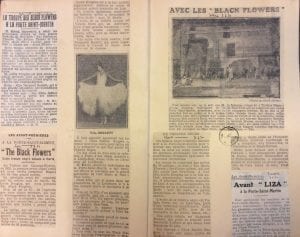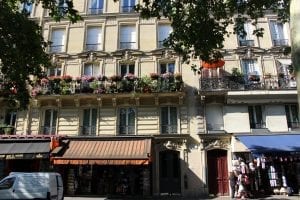A couple of weeks ago, I spent 14 days in Paris, looking in several archives for documents and sources that would help us in our research. I was armed with a list of gaps in the data about Second Viennese School performances, an iPad and a digital camera, a list of potentially helpful-looking call numbers, and a letter from Professor Epstein that I was praying would be enough to get me a reader’s card at the Bibliothèque Nationale. (Spoiler: they let me in.) Here’s what I found, what I thought, and how it all went down:
The Places:
- The Département des Arts du Spectacle at the Richelieu location of the Bibliotheque Nationale is where I spent the majority of my time. Here, the BnF houses documents about musical and theatrical performance. Once I learned the ropes, I was able to find several collections of old programs, magazines, and newspaper clippings on jazz groups in music halls-a massive help in my search to catalogue specific details about jazz performances.

The Salle de Lecture at the Département des Arts du Spectacle
- The Département de la Musique is right across the street from the Arts du Spectacle building. Here, I spent two glorious rainy afternoons with a decade of issues from Le Guide du Concert, a periodical that catalogued just about every performance of classical music in Paris (including the location, time, performing organization, and PROGRAM INFORMATION!). Luckily, I was able to find information that filled in most of the leftover data gaps in Stella’s Second Viennese School project. In fact, Le Guide du Concert is such a fantastic resource that the St. Olaf Library actually arranged to get a microfilm copy of it! Next summer, the team will have it ready at their disposal rather than several thousand miles away.
- The Mediathèque Musicale Malher is a smaller private archive. It has a large collection of newspaper clippings of articles written by Emile Vuillermoz, who was a music critic. I looked through his writing for mentions of performances by composers in the Second Viennese School (Schoenberg, Berg, and Webern), as well as for reviews of performances by orchestral organizations like the Concerts Pasdeloup, Colonne, Lamoureux, Straram, Koussevitzky, and Siohan. While I was looking, I stumbled across a couple Ballets Russes performance reviews as well.
- I went to the Archives de la Préfecture de Police to follow a lead about noise complaints in response to jazz musicians playing late at night in Montparnasse. Unfortunately, I didn’t quite have enough time there to find what we were looking for- I’m sure the information is there, but the catalogue is a bit vague and difficult to navigate, so who knows which box of newspaper clippings and police reports is the goldmine.
-

The Salle Ovale at the BnF Richelieu site. It’s super pretty, but this is where I read a lot of microfilm, which is a generally frustrating process.
On days when the libraries were closed, I walked around various parts of the city taking photographs of theaters and concert halls that were significant during the 1920s, as well as of the residences of some composers. Many of these were used in our exhibit at the Alliance Française earlier this week, and some will also get incorporated into our maps.
The Thoughts:
- Archival research is indimidating at first, since there is a fairly extensive process for applying for a reader’s card, and even after that there are a lot of procedural rules that you kind of have to learn for yourself. No one tells you that you have to submit your document requests at specific times a day, or that you have to fill out a special form if you want to leave and come back later-you just get a resigned look from the librarian that clearly says she thinks you’re off your rocker. It takes a couple days to get used to, but it’s a good feeling to be able to figure things out for yourself.
- A good rule of thumb: the smaller the archive, the friendlier the librarians.
- Finding the documents that you’re looking for can be so rewarding. It’s a unique experience in the first place to be able to sort through newpaper clippings or concert programs that are almost a hundred years old, and when you find relevant information it gets exciting, like you’re solving some great mystery, even if you just found the address of one obscure venue.
- There are sometimes entire days when you find lots of things that are interesting, but none that are remotely useful.
- On the flip side, that makes the times when things fall into place all the more exciting. It was a major victory when I recognized a newspaper clipping cited in a book we’d read earlier in the summer, or when I finally got to see hard copies of a collection of music hall programs rather than having to read them on microfilm.
- It’s a bit of a strange feeling to be in the city where all of the events we’re researching took place. I can read a review of an opera performance in the library, and then walk down a few streets and run into the opera house where it took place. Our whole project is about making place and geography come to life, and to make the experience of Paris in the 1920s accesible even though you can’t be there. This research will make Paris come to life for students and website users, but for me Paris also made the research come to life. Having absorbed so much information about the city beforehand completely transformed my experience of being there. Even though it was a foreign country, I was constantly running into familiar names and faces from history. Whenever I passed a restaurant with the lunch special
named after Jean Cocteau, or recognized a street name from our maps, I was oddly comforted.
As a final word, I’m very thankful that I was able to have this opportunity. I learned an incredible amount from the experience, and my worst fear of Not Finding Anything Helpful At All was fortunately not realized. I’m so grateful to Professor Epstein, the CURI program, and the St. Olaf International and Off-Campus Studies office for helping this part of the project become a reality.


You must be logged in to post a comment.